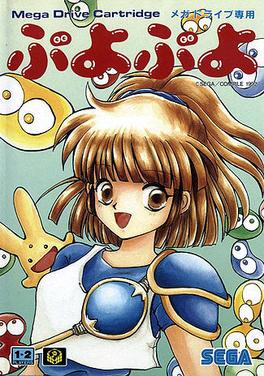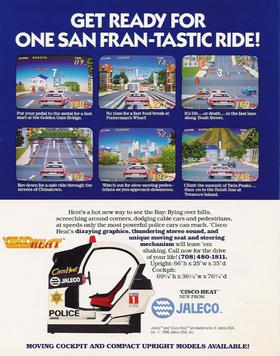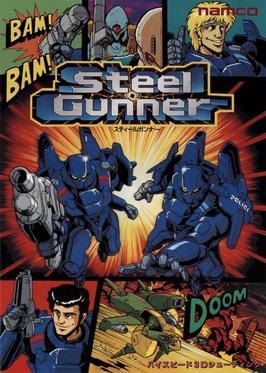
Puyo Puyo (ぷよぷよ) is a puzzle video game released in 1991 by Compile for the MSX2. Since its creation, it uses characters from Madō Monogatari. It was created by Masamitsu "Moo" Niitani, the founder of Compile, who was inspired by certain elements from the Tetris and Dr. Mario series of games.

Border Down is a horizontally scrolling shooter video game developed and published by G.rev. It was released in Japanese arcades in April 2003 on Sega NAOMI hardware, and was ported to the Dreamcast later that year. The story takes place in the future where humans are defending their Mars colony from an invading alien attack. The game employs a "border system" where each stage has three variations of different difficulty. The player starts on the easiest variation, and is lowered to a more difficult variation with each subsequent loss of a life.

Hang-On is an arcade racing game released by Sega in 1985 and later ported to the Master System. In the game, the player controls a motorcycle against time and other computer-controlled bikes. It was one of the first arcade games to use 16-bit graphics and uses the Super Scaler arcade system board, created with design input from Yu Suzuki, as technology to simulate 3D effects. The deluxe cabinet version also introduced a motion-controlled arcade cabinet, where the player's body movement on a large motorbike-shaped cabinet corresponds with the player character's movements on screen.

Cisco Heat: All American Police Car Race is a 1990 racing video game developed and published in arcades by Jaleco. Players control a police squad car racing against computer-controlled vehicles. The goal is to finish each race in first place. Players can take different routes to bypass certain portions of the course. Three cabinet types were created, a standard upright, a sit-down, and a motion-based "deluxe" machine; both of these could be connected, or "linked", together to enable multiplayer.

SegaSonic the Hedgehog is a 1993 arcade game in the Sonic the Hedgehog series by Sega. Controlling Sonic the Hedgehog and his friends Mighty the Armadillo and Ray the Flying Squirrel, the player must escape an island after they are kidnapped by the villain, Doctor Eggman. The game uses an isometric perspective. Players use a trackball to move the characters while dodging obstacles and collecting rings. The game was developed by Sega's arcade division, Sega AM3. It is one of four Sonic games with the SegaSonic name and was inspired by the 1984 game Marble Madness.

Derby Owners Club is a horse racing arcade game developed by Sega AM3 and published by Sega. Players are put into the roles of breeder, trainer, jockey, and owner of a thoroughbred racehorse. Statistics are saved on a IC card that can be put into any machine. The first version was released in Japan in 1999 and ran on the NAOMI arcade board.

Special Criminal Investigation, also known as S.C.I. for short or as Chase HQ II: Special Criminal Investigation in some home versions, is vehicular combat racing game published by Taito for arcades in 1989. It is the sequel to the 1988 game Chase H.Q.

World Club Champion Football is a Japanese collectible card game and football/soccer sports arcade video game released by Sega. The game is officially abbreviated as WCCF. It is the first arcade game to combine trading cards with a video game, establishing a new genre of arcade game. The game was mostly released in Japan and has never received a port.

Steel Gunner is a 1990 first-person shooter arcade game developed and published by Namco. Players take control of Garcia and Cliff, a duo of police officers that are part of the Neo Arc police force, as they must use their powerful Gargoyle mecha suits to destroy the STURM terrorist organization, who have taken captive scientists Dr. Ryan and Dr. Ellis to create a world-ending superweapon. Gameplay revolves around using a crosshair to shoot down enemies and avoid harming civilians. It runs on the Namco System 2 Plus arcade hardware.

GP Rider is a motorcycle racing game developed and manufactured by Sega, released in as an arcade video game in Japan, North America and Europe. It came in a two-player motion simulator cabinet and a standard upright cabinet. It was ported to the Master System in 1993 and then Game Gear in 1994.

Sangokushi Taisen is a hybrid physical and digital collectible card game for the arcade, on the Chihiro arcade board. It is a real-time strategy-based game set in the Three Kingdoms period of Chinese history and the 14th century Chinese novel Romance of the Three Kingdoms by Luo Guanzhong. It uses the same housing as World Club Champion Football, with a sensitive playing area that can detect the position of the physical cards. Over 500 million trading cards have been shipped. It is the sixth trading card arcade game by Sega, following World Club Champion Football,Mushiking: The King of Beetles, The Key of Avalon,Love and Berry: Dress up and Dance! and Quest of D.

Buggy Boy, known as Speed Buggy in North America, is an off-road racing game developed by Tatsumi and released for arcades in 1985. The cockpit version of the arcade cabinet has a panoramic three-screen display, a feature previously employed in TX-1, but with Buggy Boy having a larger cabinet. An upright, single-screen cabinet was released in 1986 under the name Buggy Boy Junior.

Monaco GP is an arcade racing game released by Sega in November 1979 in Japan, and January 1980 worldwide. An upgraded version, Pro Monaco GP, was released later in 1980. One of the last Sega games to use TTL chips instead of a microprocessor CPU, the game has players race against a clock and pass rival racers while attempting to earn points driving through five areas.

Thunder Blade is a third-person shoot 'em up video game released by Sega for arcades in 1987. Players control a helicopter to destroy enemy vehicles. The game was released as a standard stand-up arcade cabinet with force feedback, as the joystick vibrates. A helicopter shaped sit-down model was released, replacing the force feedback with a cockpit seat that moves in tandem with the joystick. It is a motion simulator cabinet, like the previous Sega Super Scaler games Space Harrier (1985) and After Burner (1987). The game's plot and setting was inspired by the film Blue Thunder (1983).

This is a list of development studios owned by Sega, a Japanese video game developer and publisher based in Tokyo, Japan. Accompanied with the list is their history of game development. Also included are the companies that Sega has acquired over the years. For a full list of games developed and published by Sega, see List of Sega video games, List of Sega mobile games and List of Sega arcade games.

F1 Exhaust Note is a two-player racing game released for arcades in 1991, modeled on Formula One racing. The game has a standard dual racing cabinet setup. Each player station has a 25-inch monitor, steering controls, shift controls, pedals, and a decorative seat. The sound originates from the back of the seat giving the player surround sound effect. The game ran on the Sega System 32 arcade hardware.

Dragon Treasure is an arcade game developed by Overworks and published by Sega in 2003 for the Sega NAOMI arcade board for Japanese arcades. The game is a coin-pusher game combined with a role-playing game, and can be played by multiple people. Progress can be stored on an IC card and can be resumed on any machine, which was new for medal games in Japan at the time. It received two sequels with Dragon Treasure II in 2004 and Dragon Treasure III in 2005.

Sega Net Mahjong MJ is a mahjong arcade game developed by Sega AM2 and released by Sega. The first version for arcades was released in July 2002 for the Sega NAOMI 2 arcade system. It featured online features with ranking, customization and recording your play history, using the experience that AM2 had developed from Virtua Fighter 4 and VF.NET. It received numerous updates and sequels since then.



















